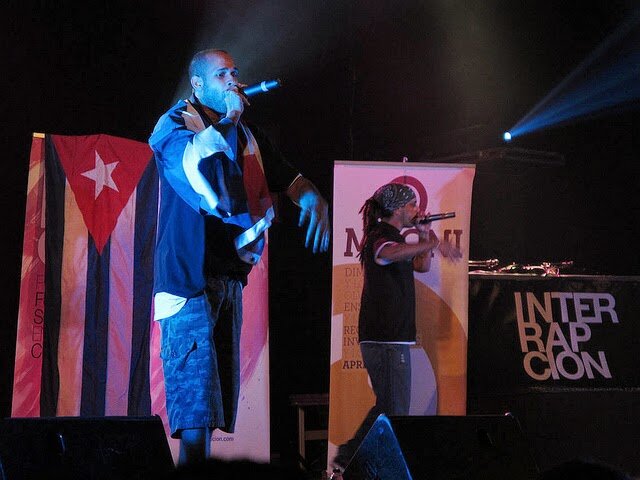Cuban Rap: The Sound of Resistance
Cuban Hip Hop group Los Aldeanos ~ Photo by: Oriana Eliçabe
Most urban music in Cuba has its roots in African-American sounds, including genres such as soul, rhythm and blues, and rap. Since 1980, popular African-American rhythms have been listened to throughout Cuba, especially those derived from funk and avant-garde artists of black pop, but it wasn’t until the following decade that rap made its appearance on the island.
Rap reached Cuba via homemade antennas that caught international radio stations. Hip-hop made the most impact on the East side of Havana, specifically in Alamar, Cojímar, Regla, Guanabacoa, and spreading as far as Cárdenas and Varadero in Matanzas. Additionally, in Guantánamo, where the United States Naval Base is located, U.S. television stations permanently broadcasted which made it possible for rap to permeate eastern and central Cuba.
In the 1990s, groups who identified with this musical trend called themselves “moñeros” (rappers and hip-hop artists). This led to an alternative Cuban scene, distanced from the government institutions in charge of influencing and disseminating culture. Some Cuban intellectuals coined the name "the other Cuba" for this alternative cultural expression.
Although hip-hop emerged as an underground phenomenon, its new musical style impressed musical talents such as jazz pianist, Chucho Valdés, who composed, "Rap de los Gordos," for his band Irakere and also pianist and composer, Adalberto Alvarez. These popular Cuban artists adopted rap and often fused it with other Cuban genres.
1990s Cuban rap was a mimesis of the U.S. style. With little access to music recording technology, many artists resorted to recording their tracks on cassettes in order to create their own sounds. The strong U.S. influence caused the Cuban government to reject this musical genre. Since there was no organized, official rap movement, casual gatherings of moñeros arose in peripheral places known as bonches (parties). This hip-hop culture is closely related to the introduction of graffiti in Cuba and to an often carefree, questioning, and rebellious attitude.
The rap group La Alianza performing at the Alamar hip hop festival ~ photo by Jason J. A. Anasarias
In 1995, the first hip-hop festival was held in Alamar, East Havana. From that moment on, hip-hop culture began to be known as a movement as artists gained fame and financial remuneration. One noteworthy example includes singer-songwriter and guitarist, Athanai Castro, with his song, “Soy un Blanco Rapero,” from the album, “Séptimo Cielo” (1997), who was also the musical producer of the first Cuban rap album, “Igual que Tú ”(1998), from the group “Primera Base.”
Since the 2000s, Cuban rap has become more mainstream with the creation of the Cuban Rap Agency (Agencia Cubana de Rap) to commercialize artists' work. Popular Cuban rap groups such as Orishas, have spread beyond Cuba and gained notoriety in other regions of the world. The film, Habana Blues (2005), by Spanish director, Benito Zambrano, helped propel Cuban rap by advocating for this emerging musical genre of the island nation.
Despite the benefits of commercial representation offered by the Cuban Rap Agency, artists began to want more freedom when deciding with whom to work and what to produce. These artists believed that a single agency affected the creative liberty that hip-hop stood for. Outspoken amongst these artists was the group, Los Aldeanos.
The Cuban Rap Agency building in Havana, Cuba.
This gave way to conflicting sides of rap in Cuba: critical and commercial. Critical "underground" rap tends to represent the interests and realities of marginalized communities, embodies urban poetry, and refers to the implications of Cuban society after the "Special Period.” In many cases, this trend has remained experimental and musically creative. On the other hand, commercial rap tends to be less edgy and more conformist to what is “culturally acceptable.” Unsurprisingly, this type of rap is mainstream and has even led to several artists abandoning rap altogether to pursue ever-popular reggaeton.
Rap often utilizes parts of high culture to create a new one, a culture of resistance, but in the case of Cuba, there is no high culture but rather a culture promoted and strengthened institutionally, which is portrayed as the "culture of the people." Sometimes it succeeds, and other times not. In those empty spaces left by institutionalized culture, artistic manifestations such as underground Cuban rap sneak in.
To this day, Cuban rap is thriving and evolving despite the obstacles artists face. Thankfully, progress has been made and continues as the government and society accept what is still viewed as an alternative culture. Groups of skaters proliferate Havana's Prado promenade, various community projects fill central Havana streets with graffiti, and breakdancing and freestyle competitions are organized such as the “Batalla de los Gallos”. There is hope for a flourishing Cuban rap scene as society slowly allows spaces for more alternative expressions.



